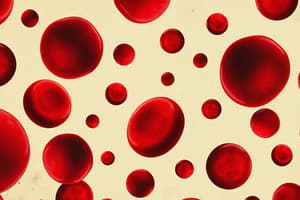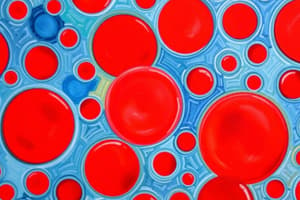Podcast
Questions and Answers
Which of these options are correct about the blood?
Which of these options are correct about the blood?
- The density of the blood is 2 times more the density of the water (correct)
- With a severe anemia the haematocrit is higher than the normal values
- The haematocrit is the number of RBC that we have in blood
- The red colour is given by the platelets
- Its medium pH is around 7.4 (correct)
Which ion is the regulator of acid-base balance and CO2 transport?
Which ion is the regulator of acid-base balance and CO2 transport?
- Phosphate
- Sodium
- Carbonate (correct)
- Calcium
- Chlorine
In pernicious anemia the basic abnormality is:
In pernicious anemia the basic abnormality is:
- There is a fail to produce gastric secretions as IF, having a lack in vit.B12 (correct)
- There is a lack in folic acid
- We obtain too much vit.B12
- Elongated crystals are created inside the RBC
- All of the above are true
About the red blood cells. Which is false?
About the red blood cells. Which is false?
Which is true about leukocytes?
Which is true about leukocytes?
Explain the mechanism of blood clot retraction:
Explain the mechanism of blood clot retraction:
Flashcards
What is Albumin?
What is Albumin?
Albumin is a protein synthesized by the liver. It helps to maintain the osmotic pressure of the blood and transports various substances like fatty acids, cholesterol, hormones, and drugs.
Which statement about blood is correct?
Which statement about blood is correct?
The correct answer is (b) Its medium pH is around 7.4. Blood is slightly alkaline, which is essential for proper functioning.
Which statement about blood is incorrect?
Which statement about blood is incorrect?
The false statement is (e) About 60% of the blood is plasma and 40% is RBC, but these percentages can vary considerably in different people, depending on gender, weight and other factors. While plasma is the major component, the RBC percentage varies significantly based on individual factors.
Which ion regulates acid-base balance and CO2 transport?
Which ion regulates acid-base balance and CO2 transport?
Signup and view all the flashcards
What's the first recognizable cell in the red blood cell series?
What's the first recognizable cell in the red blood cell series?
Signup and view all the flashcards
Where is 90% of Erythropoietin created?
Where is 90% of Erythropoietin created?
Signup and view all the flashcards
What's the main issue in Pernicious Anemia?
What's the main issue in Pernicious Anemia?
Signup and view all the flashcards
Which statement about red blood cells is incorrect?
Which statement about red blood cells is incorrect?
Signup and view all the flashcards
What's true about leukocytes?
What's true about leukocytes?
Signup and view all the flashcards
Which statement about leukocytes is correct?
Which statement about leukocytes is correct?
Signup and view all the flashcards
Which statement about chemotaxis is true?
Which statement about chemotaxis is true?
Signup and view all the flashcards
Explain the Monocyte-Macrophage Cell System in the Lungs.
Explain the Monocyte-Macrophage Cell System in the Lungs.
Signup and view all the flashcards
What are the steps of the neutrophil and macrophage response during inflammation?
What are the steps of the neutrophil and macrophage response during inflammation?
Signup and view all the flashcards
Which of these is NOT a typical feature of inflammation?
Which of these is NOT a typical feature of inflammation?
Signup and view all the flashcards
Which of these definitions is FALSE?
Which of these definitions is FALSE?
Signup and view all the flashcards
About pus formation: Which is CORRECT?
About pus formation: Which is CORRECT?
Signup and view all the flashcards
Which is NOT a characteristic of the thymus?
Which is NOT a characteristic of the thymus?
Signup and view all the flashcards
Which statement about the immune system is true?
Which statement about the immune system is true?
Signup and view all the flashcards
Which statement about lymph nodes is correct?
Which statement about lymph nodes is correct?
Signup and view all the flashcards
Describe the characteristics of the innate immune system.
Describe the characteristics of the innate immune system.
Signup and view all the flashcards
Choose the INCORRECT statement about acquired immunity.
Choose the INCORRECT statement about acquired immunity.
Signup and view all the flashcards
Select the CORRECT statement about acquired immunity.
Select the CORRECT statement about acquired immunity.
Signup and view all the flashcards
What are the two types of acquired immunity?
What are the two types of acquired immunity?
Signup and view all the flashcards
MHC class I is encoded by human leukocyte antigen genes HLA-DP,HLA-DR and...
MHC class I is encoded by human leukocyte antigen genes HLA-DP,HLA-DR and...
Signup and view all the flashcards
Which statement about the immune response is correct?
Which statement about the immune response is correct?
Signup and view all the flashcards
Choose the correct answer about MHC class I.
Choose the correct answer about MHC class I.
Signup and view all the flashcards
What are the main functions of the complement system?
What are the main functions of the complement system?
Signup and view all the flashcards
Which term means prevention of blood loss?
Which term means prevention of blood loss?
Signup and view all the flashcards
What is the main function of circulation?
What is the main function of circulation?
Signup and view all the flashcards
What is the mean pressure of the aorta?
What is the mean pressure of the aorta?
Signup and view all the flashcards
Nervous signals specially...
Nervous signals specially...
Signup and view all the flashcards
How is arterial pressure regulated?
How is arterial pressure regulated?
Signup and view all the flashcards
Explain the basic principles of circulation
Explain the basic principles of circulation
Signup and view all the flashcards
TRUE ABOUT BLOOD FLOW:
TRUE ABOUT BLOOD FLOW:
Signup and view all the flashcards
FALSE CONDITION TO OCCUR TURBULENCE IN THE PROXIMAL AORTA AND PULMONARY ARTERY:
FALSE CONDITION TO OCCUR TURBULENCE IN THE PROXIMAL AORTA AND PULMONARY ARTERY:
Signup and view all the flashcards
NAME AND EXPLAIN BRIEFLY THE 2 FACTORS THAT DETERMIINE THE BLOOD FLOW THROUGH A BLOOD VESSEL:
NAME AND EXPLAIN BRIEFLY THE 2 FACTORS THAT DETERMIINE THE BLOOD FLOW THROUGH A BLOOD VESSEL:
Signup and view all the flashcards
Conductance of blood in a vessel is said to be:
Conductance of blood in a vessel is said to be:
Signup and view all the flashcards
Which of the following sentences is true?
Which of the following sentences is true?
Signup and view all the flashcards
Poiseuille’s Law.
Poiseuille’s Law.
Signup and view all the flashcards
Which of these statements about blood vessels distensibility is true?
Which of these statements about blood vessels distensibility is true?
Signup and view all the flashcards
Which of this statements is true?
Which of this statements is true?
Signup and view all the flashcards
Which are the factors that affect pulse pressure:
Which are the factors that affect pulse pressure:
Signup and view all the flashcards
which sentence is true about the osmotic pressure:
which sentence is true about the osmotic pressure:
Signup and view all the flashcards
which sentence is true about the “Starling forces”:
which sentence is true about the “Starling forces”:
Signup and view all the flashcards
which sentence is false about the lymphatic system:
which sentence is false about the lymphatic system:
Signup and view all the flashcards
Which of this statements about the pores is true?
Which of this statements about the pores is true?
Signup and view all the flashcards
The most important factor found thus far to affect the degree of opening and closing of the metarterioles and precapillary sphincters is...
The most important factor found thus far to affect the degree of opening and closing of the metarterioles and precapillary sphincters is...
Signup and view all the flashcards
The cyclical opening and closing of precapillary sphincters is called
The cyclical opening and closing of precapillary sphincters is called
Signup and view all the flashcards
Which is a powerful vasoconstrictor hormone?
Which is a powerful vasoconstrictor hormone?
Signup and view all the flashcards
An increase in carbon dioxide concentration causes a highly marked vasodilatation in:
An increase in carbon dioxide concentration causes a highly marked vasodilatation in:
Signup and view all the flashcards
Which are the functions of the circulatory system?
Which are the functions of the circulatory system?
Signup and view all the flashcards
Which of these about nervous regulation of circulation is true?
Which of these about nervous regulation of circulation is true?
Signup and view all the flashcards
Which of these locations is true?
Which of these locations is true?
Signup and view all the flashcards
Which of these sentences is false about the arterial pressure?
Which of these sentences is false about the arterial pressure?
Signup and view all the flashcards
What is false about baroreceptors?
What is false about baroreceptors?
Signup and view all the flashcards
Study Notes
Blood Composition
- Blood is a complex fluid, primarily composed of plasma (approximately 60%) and formed elements (approximately 40%).
- Plasma is the liquid component and contains water, proteins (e.g., albumin), electrolytes, nutrients, hormones, and waste products.
- Formed elements include red blood cells (erythrocytes), white blood cells (leukocytes), and platelets (thrombocytes).
- Albumin is a crucial plasma protein synthesized by the liver. It plays a role in maintaining blood osmotic pressure and transporting various substances.
- Blood pH is around 7.4.
- Blood density is approximately twice the density of water.
Red Blood Cell Differentiation
- Red blood cells (RBCs) originate from stem cells called CFU-E.
- Proerythroblasts are the first identifiable cells in the RBC lineage.
- Erythroblasts, are successively formed, accumulating hemoglobin (HGB).
- The nucleus condenses and is ejected to create mature reticulocytes.
- Reticulocytes enter the bloodstream and mature into erythrocytes within 1–2 days.
- Normal erythrocyte lifespan is approximately 120 days.
- Erythropoietin (EPO) is predominantly produced in the kidney (90%) and regulates red blood cell production.
Blood Ions and Acid-Base Balance
- Carbonate is a crucial ion for regulating acid-base balance and CO2 transport.
- Other electrolytes, such as sodium, calcium, and chlorine, also play significant roles in blood function.
Studying That Suits You
Use AI to generate personalized quizzes and flashcards to suit your learning preferences.




